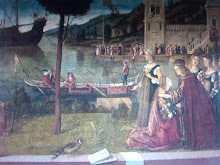.jpg)
Monday, October 4, 2010
Brunelleschi- Risk Taker
.jpg)
Brunelleschi was definitely a risk taker because he challenged new ideas that had not been tested. Building a dome weighing 37,000 tons consisting of 4,000,000 bricks was not a simple feat during the renaissance. He had to convince the church and those involved that this could be done. During the 14th century as Santa Maria del Fiore (the Duomo) was constructed, the Opera de Duomo which oversaw the construction held a competition to see who could build a dome on the cathedral. It was Brunelleschi who won the competition. He convinced the authorities by standing an egg upright breaking its bottom. It was almost an impossible mission as Brunelleschi "had to rewrite the rules of Western architecture and there was no guarantee of success." At that time, there was a shortage of timber in tuscany which could be used for building scaffolds in the cathedral, so Brunelleschi had to think of a new idea to make this possible. Ingeniously, "his plans showed an inner hemispherical dome within the cathedral's octagonal drum, a second ovoid brick was placed on top held by nine sandstone rings." To raise the bricks and sandstone beams, he invented a hoist to raise them; this was the world's first reverse gear invented. Everyday he came up with new ideas to finally complete the task proving that his theory was workable when many doubted it. Even when there are times when he could have doubted himself, he persevered by inventing new methods and coming up with unconventional ideas to overcome his obstacles. He was willing to take risk when he was unsure of the outcome. It was his risk taking spirit that the Duomo was the largest masonry dome ever built. Fillipo Brunelleschi reinvented engineering and architecture proving himself to be the greatest architect and engineer of the Renaissance.
His dome could not have been created without the help of the Medici family. Because he had the support of the Medici, the church had no choice but to support him. Because his idea wasn't fully tested, they could only hope for his creation to hold up. Each time he proved that his new method works, people began to have more faith in him. Had the church not given him a chance, new engineering methods would not have been discovered. He was the first engineer of the Renaissance.
Subscribe to:
Posts (Atom)
